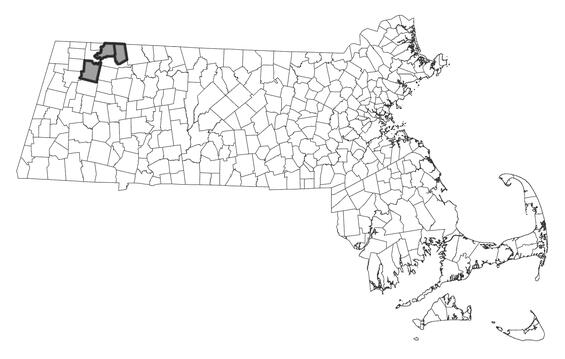- Scientific name: Myriophyllum farwellii
- Species of Greatest Conservation Need (MA State Wildlife Action Plan)
- Endangered (MA Endangered Species Act)
Description
Farwell’s water-milfoil (Myriophyllum farwellii) is an aquatic herb of the Haloragraceae family. The plant grows wholly submersed in water. Inconspicuous, sessile flowers are arranged in the axils of the finely dissected foliage. The stems are elongate and narrow. Unlike most members of this genus in the Northeast, this species is wholly submerged and does not produce a terminal inflorescence of flowers. Instead, flowers are born in the axils of the leaves. Another feature less common in this genus is the presence of turions, which are small, bulb-like propagules that allow the plant to spread vegetatively. In this species, the turions are produced at or near the tips of the stems. Additionally, the backs of each fruit bear a bumpy ridge. The combination of these characters, plus the presence of alternate, sub-opposite, or scattered leaves (not whorled), serves to distinguish this species from the other milfoils in Massachusetts.
Common water-milfoils could be confused with Farwell’s water-milfoil. However, the two invasive species of water-milfoil, Eurasian water-milfoil (Myriophyllum spicatum) and variable water-milfoil (M. heterophyllum), both have whorled leaves. In addition, these species both produce emergent, terminal inflorescences of flowers rather than axillary flowers. Lowly water-milfoil (M. humile), a common native water-milfoil, also has axillary flowers but differs in having smooth fruits.
Life cycle and behavior
This is a perennial species.
Population status
The Massachusetts Natural Heritage & Endangered Species Program has 3 records from 1 county: Franklin. Two of these records have been observed within the last 25 years.

Distribution in Massachusetts. 1999-2024. Based on records in the Natural Heritage Database.
Distribution and abundance
Farwell’s water-milfoil is primarily a northern species and approaches the southern limit of its range in Massachusetts. The species ranges from Newfoundland west to Alaska, south to Pennsylvania and Minnesota. Our occurrences of this species are in the northwestern part of the state.
Habitat
In Massachusetts, Farwell’s water-milfoil is found in shallow waters of cold acidic ponds. It has been found growing in association with purple bladderwort (Utricularia purpurea), water shield (Brasenia schreberi), spatterdock (Nuphar variegata), and floating-leaved bur-reed (Sparganium fluctuans).
Healthy habitats are vital for supporting native wildlife and plants. Explore habitats and learn about conservation and restoration in Massachusetts.
Threats
Liming to counteract acid rain impacts, which has occurred in nearby ponds, could disrupt this species. Aquatic invasive species such as Eurasian watermilfoil and other species can pose a threat. Broad herbicide application to control aquatic plants may also threaten this species. Other threats include pondshore development, nutrification from lawn or farm fertilizer, soil erosion in the watershed. This being a species of more northerly distribution, climate warming is a potential threat. The past 130 years have seen a warming of 1.4 degrees C, (2.5 degrees F) in the Northeast United States (Staudinger et al. 2024). Northern species can be expected to move much further north in an attempt to occupy a habitat within their evolved climate envelope.
Conservation
Survey and monitoring
As there are only three populations currently known in Massachusetts, and that a boat is required, is it very likely this species is under-surveyed. Surveys both of past known locations and new potential sites are needed. The best time to survey for it is when it is in fruit from mid-August through early September.
Management
The ecological needs of this species are not well understood, so management needs are not well known. However, controlling invasive aquatic species may be needed, as might maintenance or restoration of hydrology. Hand-pulling of aquatic invasive species is recommended around populations of rare aquatic species. This can include pulling done with SCUBA gear which has shown to be effective in some situations. All active management of rare plant populations (including invasive species removal) is subject to review under the Massachusetts Endangered Species Act and should be planned in close consultation with the MassWildlife’s Natural Heritage & Endangered Species Program.
Research needs
The exact ecological needs of this species are not well understood. As this plant is under-surveyed, standard information is needed such as lists of associated species, comments on water and habitat quality and threats, and assessments of soil conditions and phenology. Research is needed to determine whether this plant can be grown in an aquarium or small pool in a greenhouse or garden setting for purposes of reintroductions. If habitat degradation accelerates losses of current populations, this strategy could prove useful to long-term conservation of this species.
References
Staudinger, M.D., A.V. Karmalkar, K. Terwilliger, K. Burgio, A. Lubeck, H. Higgins, T. Rice, T.L. Morelli, A. D'Amato. 2024. A regional synthesis of climate data to inform the 2025 State Wildlife Action Plans in the Northeast U.S. DOI Northeast Climate Adaptation Science Center Cooperator Report. 406 p. https://doi.org/10.21429/t352-9q86
Contact
| Date published: | May 8, 2025 |
|---|